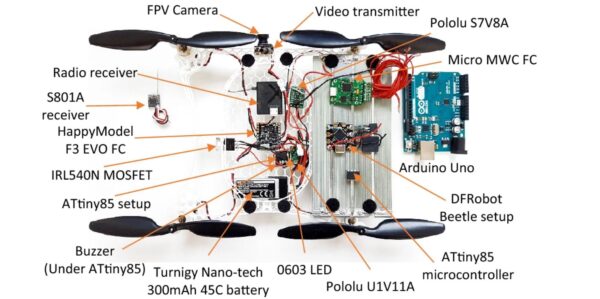- Researchers at the Queen Mary University of London have fabricated a prototype of a multirotor micro aerial vehicle that is powered by photovoltaic energy and can reportedly fly for an average time of 3.5 min.
The scientists claim their micro drone is the smallest solar-rechargeable multi-rotor ever developed to date, measuring 0.15 m x 0.15 m and having a weight of only 0.071 kg.
For the PV system, the research team chose solar cells with a power per unit surface area of 219 W/m2, which are produced by US-based Sunpower. It used a micro module with a thickness of 0.000165 m, a mass of 0.0063 kg, a surface area of 0.0156 m2, and a power conversion efficiency of 22.6%.
For the drone technology, they utilized a commercially available M:Tech quadcopter with an electrical power consumption of 3.57 W. “The minimum power requirements of the M:Tech drone at hover is 2.59 times the output provided by this theoretical solar cell meeting the surface area size requirements of the micro air vehicle (MAV),” the academics explained. “The limiting factors here are the solar irradiance and the solar power conversion efficiency.”
They also stressed that the usable surface area of the quadcopter is too small to ensure solar-powered flight without energy storage. “The minimum solar panel surface area required for purely solar-powered flight would be 0.128 m × 0.128 m,” they specified. “For the Micro Solarcopter to hover purely on solar power, it will need about 12W, therefore requiring a surface area of 0.234 m × 0.234 m, which is outside the MAV size restriction.”
The aerial vehicle also integrates a 0.3 Ah storage system based on lithium polymer batteries, a 32-bit flight controller, a Nine Eagles P-51 micro electric motor, a gearbox coupled with a Turnigy Micro-quad propeller, first-person view (FPV) camera, two switching voltage regulators, a buck-boost converter, and a MOSFET for turning on and off the power to the FPV camera. “The MOSFET was strategically placed to be exposed to the rotor airflow in flight, providing some level of cooling,” the team said.
The selected battery has the best power density compared to other candidate batteries, while also showing remarkable energy density, specific power, and specific energy. “The battery is advertised as 45–90 C discharge capable,” the group stated. “The Micro Solarcopter hovers at about 15 C load on this battery.”
The battery can also enter into hibernation mode when it is fully discharged for over 40 days. In this way, the aerial vehicle does not use electricity from the battery during periods of low or no light.
Through a series of tests, the researchers found that the solar aerial vehicle can fly over 15 m in height for around 3.5 min, “depending on the defined voltage cut-off setting which directly impacts battery cycle life.” The battery can be recharged in approximately 68 min under standard illumination conditions at 25 C.
“This flight time is short compared to fixed-wing MAVs but close to multi-rotor MAV endurance figures of around 5 minutes,” they further explained. “The advantage, however, is that the Micro Solarcopter can land, hibernate and independently recharge its battery without having to return to a home base.”
Their findings were presented in the study “Development of a solar powered multirotor micro aerial vehicle,” published in scientific reports. Looking forward, they said they intend to address the drone’s recharging issues by creating moving unmanned ground vehicles that would serve as larger PV units enabling faster recharge.
Author: Emiliano Bellini
This article was originally published in pv magazine and is republished with permission.












